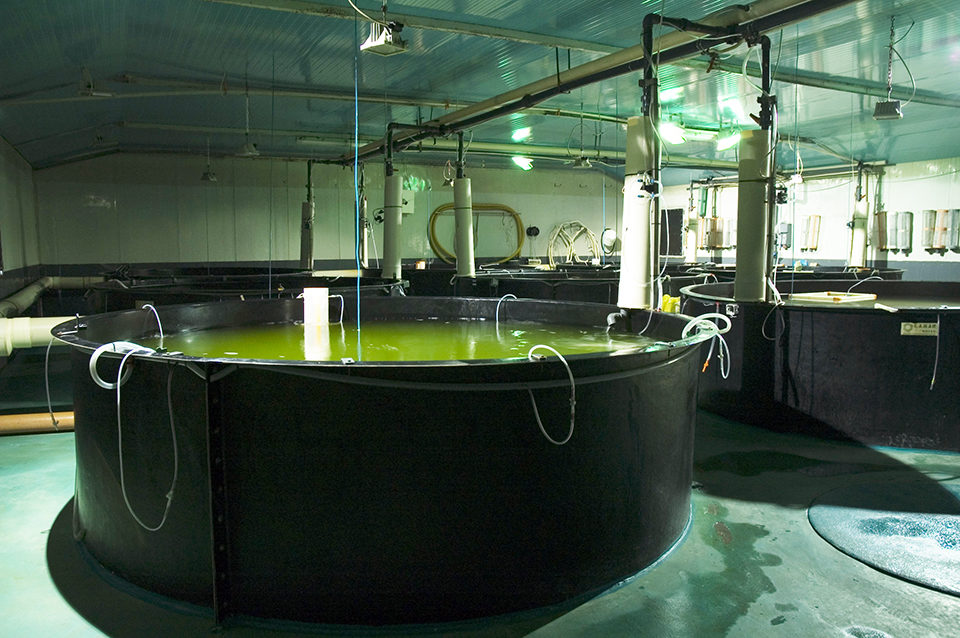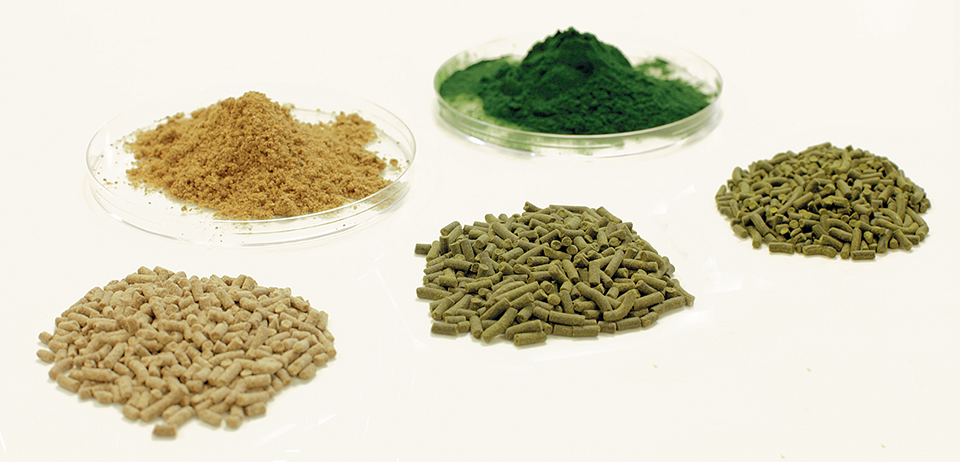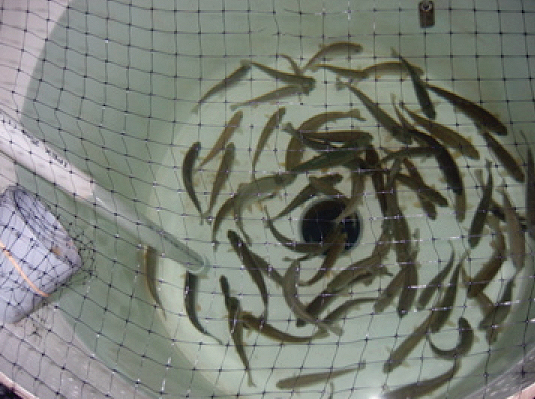Algae serves stress-reduction, nutritional and environment-optimizing roles

The successful production of high-quality seabream fry still necessitates a greenwater step in the larval-rearing phase. The multiple roles of algae as a light diffuser, nutritional conditioner of zooplankton, bacteriostatic, water quality improver and immunostimulant during the early phase of larval rearing, and their possible interactions on final fry quality after metamorphosis make finding valid alternatives a complicated matter.
Important increases in the hatchery production of seabream fry and faster turnover in the larval-rearing facilities during the last 10 years are demanding more intensive algae production. High-density algae cultivation systems and the use of concentrated algae are helping the fry producers, but an off-the-shelf substitute with long shelf life and constant quality would also help.
Maricoltura di Rosignano Solvay has worked with INVE Technologies more than four years to develop an algal substitute that could deliver the varied characteristics of algae in the commercial larviculture of gilthead sea bream.
Greenwater rearing
Seabream fry are still produced using the greenwater rearing technique. This means that during the first 20 to 30 days after hatching, microalgae are added in considerable amounts to the larval-rearing tanks. The amount of microalgae needed to produce 1 million fry is around 40,000 liters using algae produced in traditional batch cultures at an average cell density of 19.106 cells/ml or 5,000 liters using algae produced in intensive systems such as photo-bioreactors at an average cell density of 180.106 cells/ml.
The most frequently used algae are Nannochloropsis, Chlorella and Isochrysis species. All these microalgae have characteristics such as the presence of high levels of highly unsaturated fatty acids, vitamins and/or proteins, or antibacterial properties that make them indispensable for the larval rearing of seabream and other marine finfish species.
An important role of the microalgae is the creation of a shadowing effect in tanks that reduces stress for the larvae by diffusion of the incoming light. A second role is a nutritional one, be it directly for the larvae in enhancing their digestive physiology or acting as an immunostimulator, or indirectly as a feed for the rotifers in the larval-rearing tanks. A third role is optimizing the environmental conditions by acting as a water quality stabilizer and bacteriostatic against pathogenic and opportunistic bacteria in both the culture water and larvae guts.

Greenwater simulation trials
After formulation of theoretical “optimal” greenwater substitutes with a suitable size, the algal substitutes were evaluated in a greenwater simulation test using 500-liter tanks. During the trials, water coloration, physical behavior, cleanliness and sedimentation rates were evaluated during four consecutive days. Products that scored well by equalling or bettering the performance of the algae control were further evaluated in pilot-scale fish culture trials.
Pilot-scale culture trials
Preliminary tests were performed in a pilot system with 500-liter larval-rearing tanks. Seabream larvae were stocked at day 1 posthatch at a density of about 100 larvae/liter. The selected greenwater substitutes were compared in triplicate using a semiclosed water circulation system operated at a water temperature of 19 ± 1 degrees-C.
The algal substitutes were supplied daily from day 2 until day 27 without the addition of live algae. Rotifers were fed from day 3 until day 27, 420-µ artemia from day 17 until day 28, and 850-µ artemia enriched with a commercial product from day 25 until day 55. Cofeeding with dry diets was started at day 18, and weaning was completed at day 55 posthatch.
The fish were evaluated for feeding incidence during the early days of feeding, swim bladder development, survival and major visual deformities after metamorphosis. The best-performing substitutes were then evaluated on a production scale to evaluate their real potential compared with freshly cultured algae.
Production-scale trials
It was quickly possible to fully substitute live algae by dry product formulations during the complete 30-day greenwater period. The substitution resulted in survival rates over 50 percent at day 65, which was comparable to survival for fish fed algae, and over 90 percent of fish with a fully inflated swim bladder. However, extra efforts were needed to improve water quality characteristics as well as the quality of the fry in terms of deformity levels.
One formulation gave excellent results on all characteristics examined and even yielded sea bream fry of a higher quality than those reared with freshly cultured algae (Table 1). This formulation will be commercialized soon by INVE Aquaculture.
Wolf, Performance results at 55 days posthatch of seabream larvae, Table 1
| Parameter | Greenwater Substitute | Algae Control |
|---|---|---|
| Survival (%) | 47 | 43 |
| Standard length (mm) | 15.4 ± 1.1 | 14.8 ± 0.96 |
| Fish with fully inflated swim bladder | 98 | 96 |
| Fish with operculum deformities | 7 | 12 |
| Fish with tail deformities (%) | 0 | 5 |
| Fish with skeletal deformities (%) | 1 | 1 |
| Fish with normal aspect (%) | 91 | 82 |
(Editor’s Note: This article was originally published in the January/February 2009 print edition of the Global Aquaculture Advocate.)
Now that you've reached the end of the article ...
… please consider supporting GSA’s mission to advance responsible seafood practices through education, advocacy and third-party assurances. The Advocate aims to document the evolution of responsible seafood practices and share the expansive knowledge of our vast network of contributors.
By becoming a Global Seafood Alliance member, you’re ensuring that all of the pre-competitive work we do through member benefits, resources and events can continue. Individual membership costs just $50 a year.
Not a GSA member? Join us.
Authors
-
Tania De Wolf
Maricoltura di Rosignano Solvay
Via P. Gigli snc, I-57013
Rosignano Solvay, Italy[116,105,46,116,101,110,115,121,115,64,119,100,116,46,115,114,109]
-
Alessandro Moretti
Maricoltura di Rosignano Solvay
Via P. Gigli snc, I-57013
Rosignano Solvay, Italy -
Francesco Lenzi
Maricoltura di Rosignano Solvay
Via P. Gigli snc, I-57013
Rosignano Solvay, Italy -
Olivier Decamp
INVE Technologies N.V.
Dendermonde, Belgium -
Pino Candreva
INVE Technologies N.V.
Dendermonde, Belgium -
Patrick Lavens
INVE Aquaculture Health
Dendermonde, Belgium
Tagged With
Related Posts

Aquafeeds
A look at phospholipids in aquafeeds
Phospholipids are the major constituents of cell membranes and are vital to the normal function of every cell and organ. The inclusion of phospholipids in aquafeeds ensures increased growth, better survival and stress resistance, and prevention of skeletal deformities of larval and juvenile stages of fish and shellfish species.

Aquafeeds
A new nutrient for aquaculture, from microbes that consume carbon waste
Biotechnology firm NovoNutrients aims to produce a line of nutraceutical aquafeed additives as well as a bulk feed ingredient that can supplement fishmeal. Its process includes feeding carbon dioxide from industrial gas to a “microbial consortium” starring hydrogen-oxidizing bacteria.

Aquafeeds
Algae alternative: Chlorella studied as protein source in tilapia feeds
Chlorella and other species have potential as protein sources in aquafeeds. In trials with tilapia fry raised in a recirculating system, the fish received a fishmeal-based control diet or feeds with portions of the fishmeal replaced by Chlorella.

Health & Welfare
Algae shows promise as alternative DHA source in rainbow trout diets
A growth trial in Canada evaluated the use of algae biomass to increase the concentration of long-chain polyunsaturated fatty acids in the tissues of rainbow trout.



